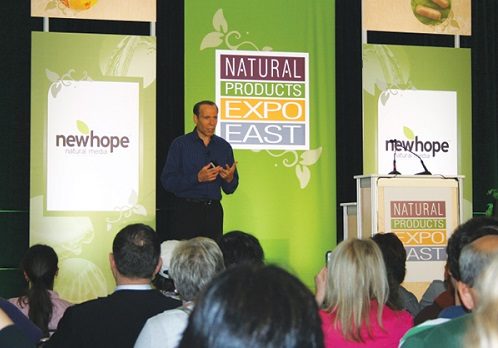WholeFoods editors attended several education sessions at Expo East 2013, and bring you some key take-home points here. Additional coverage of speakers is available in the full-length story at www.wholefoodsmagazine.com.
At a breakfast hosted by Aker BioMarine, Chris Speed, MND, APD, spoke about the benefits of krill oil. Nearly four in 10 omega-3 users are looking for alternatives to fish oil, he told listeners. Speed went on to describe the qualities of krill that distinguish it, from bioavailability to sustainability. Krill oil is clinically proven to benefit humans, and recent studies on krill have examined areas like addiction and brain chemistry, as well as obesity.
Keynote speaker Raj Sisodia spoke about the Conscious Capitalism movement, and that businesses can’t survive if greed is the key motivation.
Featured speaker Joel Fuhrman, M.D., bestselling author of Eat to Live, Eat for Health, and The End of Diabetes, gave a presentation entitled, “Super Immunity—No Heart Disease, No Strokes, No Diabetes, No Cancer.” “Deaths from heart disease are a relatively recent occurrence in human history,” Fuhrman told his audience. “They are all the result of nutritional stupidity and poor eating habits.”
An avid advocate of “nutrarian” eating, which emphasizes vegetables and fruits, moderates grain intake, and sharply limits animal fats from meat and dairy, Fuhrman said, “Normal aging alone would not bring on degenerative diseases.” Noting that a poor diet, heavy in calories but low in nutrients, is usually the culprit, he warned, “The whiter the bread, the sooner you’re dead. Just switching from white flour to whole wheat flour reduces glycemic intake by 30%.” He advised people to consume less macronutrients (protein, carbohydrates and fats) and more micronutrients (vitamins, minerals and phytochemicals) to achieve health.
“The State of the Independent Retail Industry” featured insights into the natural products channel courtesy of the latest raw sales data and consumer polling. Bill Crawford, M.S., pointed out that only 41% of natural sales took place in natural retail stores last year, while 40% took place in conventional stores, and the rest came from other outlets like practitioners. “The gap is getting very narrow,” Crawford said.
A panel of activists and experts conducted “GMOs: Where Are We Now.” Scott Faber, executive director of the Just Label It! campaign, Elizabeth Kucinich and others gave updates on their work within the non-GMO movement, including heavily encouraging support for Washington state’s Initiative 522, which awaited a vote on November 5. “We need to stop blasting our soil with pesticides and herbicides,” said David Bronner, founder of Dr. Bronner’s Magic Soaps. He added that he believes we as a society are heading in the direct opposite direction we should be heading on the GMO issue.
Cynthia A. Daley, Ph.D., a professor at the College of Agriculture, California State University, Chico, CA, said that organic research and performance have come a long way, but there is so much to do—and she left hanging the question of whether sufficient funding for organic will be forthcoming. Others on the panel with her were: Chuck Benbrook, firmer chief science officer at The Organic Center and currently research professor at Washington State University, Pullman, WA; and Dr. Kathleen Delate, professor of organic/sustainable agriculture in the Department of Agriculture and Horticulture at Iowa State University, Ames, IA.
The non-GMO Project has made some headway in identifying and certifying products that have no genetically modified organisms (GMOs), as noted in a panel on “Going GMO-Free: Striving for Perfection in an Imperfect World.” Nevertheless, numerous obstacles continue to frustrate manufacturers and confuse retail personnel attempting to distinguish between GMO and GMO-free products on their shelves.
Robert U. Craven, CEO of Derry, NH-based MegaFood, said the task of formulating GMO-free foods is comparatively easy compared to achieving the same goal with supplements. “For example,” he said, “popcorn may have as few as three ingredients—corn, salt and oil. Contrast that with a supplement that could have as many as 140 ingredients, all of which have to be tracked back to the seed and the soil. It can be very complicated.”
In her Concord, MA store Debra’s Natural Gourmet, Debra Stark tries to maintain a sense of perspective, selling some products that probably are GMO-free, but have not gone through the certification process. But, she added, “We also post the complete list of products that have been certified.”
Ben Nauman, director of purchasing for the National Cooperative Grocers Association, located in St. Paul, MN, said the retailer members of his organization have two major goals: a GMO labeling law at the national level, and aggressive promotion and education about the meaning and importance of going GMO-free.
Published in WholeFoods Magazine, November 2013 (online 10/18/13)










